IV. Price Situation - RBI - Reserve Bank of India
IV. Price Situation
Global Inflation Environment
Inflation Conditions in India
Components of Inflation
Consumer Price Inflation
Asset Prices and Inflation
Inflation in India went through episodes of pressures before edging down in the last quarter of 2003-04. Globally, inflation remained subdued in several parts of the world. Downside risks of deflation receded during the year. Prices of basic and intermediate materials firmed up in association with signs of recovery in economic activity and the persistent hardening of international crude oil prices.
Inflation remained low in 2003, although inflationary expectations began to edge up in the second half of the year as signs of recovery became stronger and widespread. Monetary policy remained accommodative in various parts of the world in support of economic recovery, albeit with a growing recognition that some reversal could be necessary in the future. In the developed countries, inflation stayed below two per cent for the second year in succession while remaining close to six per cent in developing economies. In the US, headline consumer inflation fell to 1.7 per cent in March 2004 as the slack in resource utilisation remained substantial and productivity gains led to a decline in unit labour costs. In the United Kingdom, inflation remained well below the Bank of England’s target of 2.0 per cent, although muted pressures from incipient demand growth led to a pre-emptive tightening of monetary policy. In the euro area, inflation stayed close to the European Central Bank’s target of 2.0 per cent with pressures emanating from higher oil and food prices offset by the appreciation of the euro. Japan continued to experience deflation during 2003 although recovery in real GDP growth became stronger in the second half of the year.
In developing Asia, domestic demand picked up but did not translate into inflationary pressures (Chart 23). In China, consumer prices rose moderately on account of higher prices of food, farm products and metals. Countries in Africa and the Western Hemisphere, on the other hand, continued to face relatively high inflation risks.
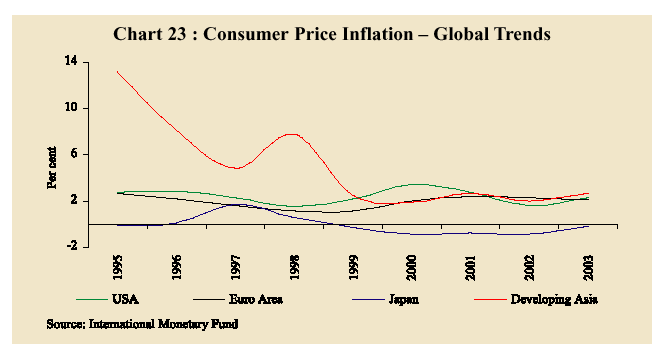
International commodity prices surged in 2003 (Chart 24). Crude oil prices hardened from 2002 levels due to slower than expected resumption of oil production in Iraq, pick-up in economic activity, low levels of inventory in industrial countries and further cuts in production by the Organisation of Petroleum Exporting Countries (OPEC). Non-fuel commodity prices also rose sharply, mainly reflecting increased Chinese demand for metals and cotton, crop failures as well as the depreciation of the US dollar - the currency in which commodity prices are generally invoiced. The large increases in commodity prices were not transmitted into consumer prices in industrial countries but appear to have been absorbed in firms’ profit margins, as commodity costs represent only a small share of overall costs in these economies.
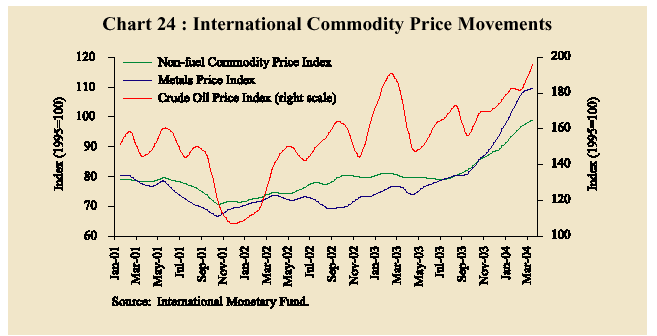
Inflation Conditions in India
Headline inflation, measured by year-on-year (y-o-y) changes in the wholesale price index (WPI), peaked at 6.9 per cent in the first week of May 2003 as transport disruptions and an upward revision in electricity prices dispelled the effect of downward revisions in petroleum, oil and lubricants (POL) prices. Inflation receded thereafter to a trough of 3.8 per cent on August 23, 2003 driven down by declines in the prices of mineral oils, fruits, oil seeds, oil cakes and chemicals. Incipient inflationary pressures began to emerge from prices of iron and steel, vegetables, sugar and administered coal. Over the subsequent weeks, inflation rose to 6.6 per cent by January 10, 2004 due to hardening prices of mineral oils, cotton textiles, iron and steel and fruits. About a fifth of this rise in inflation was due to successive hikes in domestic petrol and diesel prices on December 16, 2003 and January 1, 2004. With the delayed seasonal fall in vegetable prices, a decline in prices of eggs and poultry chicken on fears of avian influenza and base effects of oil price hikes in February and March 2003, inflation decelerated to 4.5 per cent by end-March 2004. The year-on-year WPI inflation eased further to 4.3 per cent by April 24, 2004.
Rising prices of iron and steel, cotton textiles and international crude prices posed inflation concerns in the second half of the year. Sugar prices rose in the last quarter, reflecting lower domestic sugarcane production in the western belt due to persistent drought conditions as well as upward revisions in the statutory minimum prices for sugarcane. Annual WPI inflation, excluding the administered and partially decontrolled items (electricity, coal mining, mineral oils and urea-N-content), stood at 5.1 per cent in 2003-04, on a point-to-point basis, as compared with the headline rate of 4.5 per cent. On an annual average basis, WPI inflation was 5.4 per cent in 2003-04 as compared with 3.4 per cent a year ago (Chart 25).
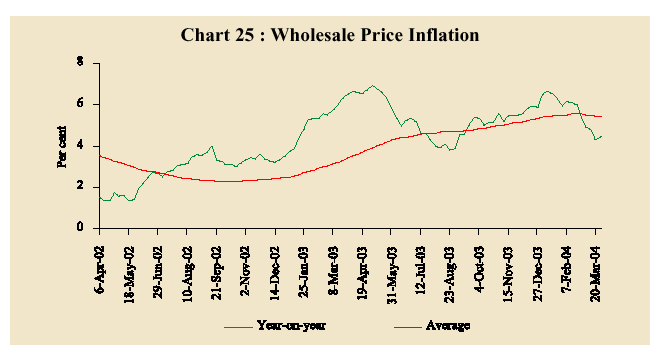
Components of Inflation
The key movers of headline inflation in 2003-04 were iron and steel, cotton textiles, fuel group, sugar and milk. These items, which have a weight of 30 per cent in the overall WPI index, accounted for 66 per cent of the headline inflation (Chart 26).
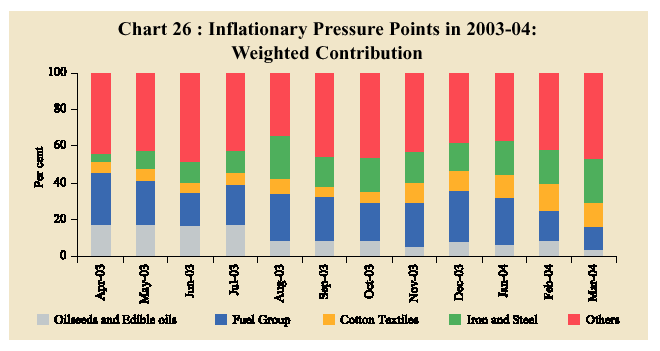
Domestic iron and steel prices increased by 34.2 per cent in 2003-04 and contributed almost a fourth of headline inflation. This was associated with the improvement in industrial activity and exports. It also reflected the movements in international prices which were driven up by increased Chinese demand for metals and rising input costs (Chart 27). During the last quarter of 2003-04, fiscal measures comprising cuts in customs and excise duties on inputs as well as finished products supported by freezing of benefits under the Duty Entitlement Pass Book and duty drawback schemes also helped in reining in inflationary pressures.
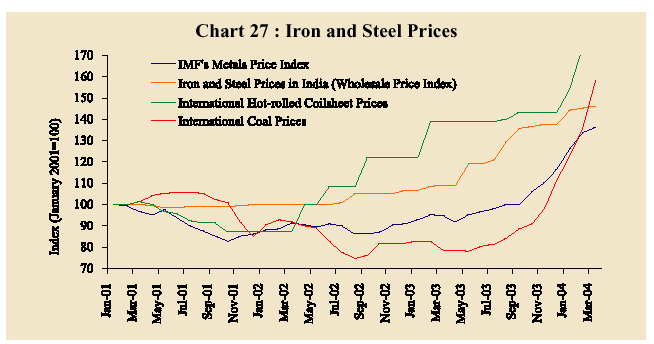
The increase in cotton textile prices was mainly on account of the rise in domestic raw cotton prices. Despite a satisfactory domestic cotton crop, raw cotton prices remained firm in consonance with international price movements. Global cotton prices increased during 2003, mainly reflecting higher Chinese demand and low stocks (Chart 28).
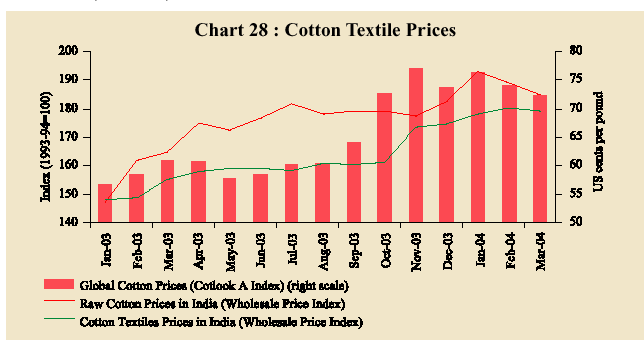
Domestic oilseeds prices were largely unchanged from their end-March 2003 level, reflecting a rebound in domestic oilseeds production. The prices of edible oils were, however, held up by import costs due to depleting Malaysian palm oil stocks and shortfalls in the production of soybean in the US (Chart 29).
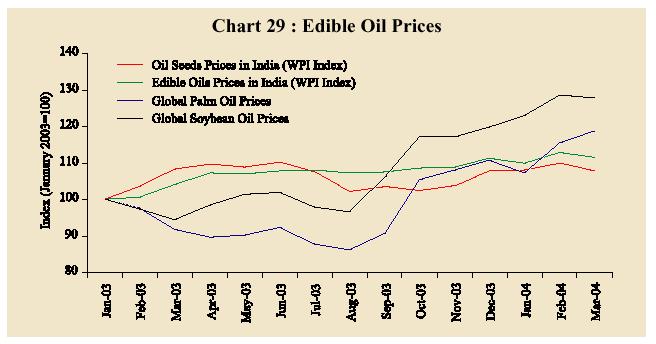
The manufactured products group contributed 78.7 per cent to inflation in 2003-04 as compared with 44.3 per cent during 2002-03 (Table 14). This was primarily due to the spurt in global commodity prices, given the near exhaustion of excess capacities in major industries alongside the revival in economic activity.
Table 14 : WPI Inflation Rate (Year-on-year)
| (Per cent) |
|||||||||
|
|
|||||||||
| Inflation Rate |
Weighted Contribution |
||||||||
| Commodity |
Weight |
2001- |
2002- |
2003- |
2001- |
2002- |
2003- |
||
| 02 |
03 |
04P |
02 |
03 |
04P |
||||
| 1 |
2 |
3 |
4 |
5 |
6 |
7 |
8 |
||
|
|
|||||||||
| All Commodities |
100.0 |
1.6 |
6.5 |
4.5 |
100.0 |
100.0 |
100.0 |
||
| 1. |
Primary Articles |
22.0 |
3.9 |
6.1 |
1.7 |
53.4 |
21.6 |
8.6 |
|
| Food Articles |
15.4 |
5.2 |
0.8 |
0.7 |
51.5 |
2.2 |
2.4 |
||
| i. |
Cereals |
4.4 |
0.8 |
4.0 |
-0.2 |
2.4 |
2.9 |
-0.2 |
|
| ii. |
Pulses |
0.6 |
-3.3 |
0.3 |
-2.8 |
-1.4 |
0.0 |
-0.4 |
|
| iii. |
Vegetables |
1.5 |
23.4 |
-15.7 |
8.0 |
14.8 |
-3.0 |
1.8 |
|
| iv. |
Fruits |
1.5 |
9.5 |
7.6 |
-7.1 |
11.2 |
2.4 |
-3.3 |
|
| v. |
Milk |
4.4 |
4.7 |
0.6 |
7.5 |
12.9 |
0.5 |
7.3 |
|
| vi. |
Eggs, Fish and Meat |
2.2 |
9.3 |
-4.0 |
-6.3 |
14.3 |
-1.7 |
-3.4 |
|
| Non-Food Articles |
6.1 |
0.6 |
22.1 |
4.3 |
2.1 |
19.3 |
6.2 |
||
| i. |
Raw Cotton |
1.4 |
-21.3 |
34.3 |
12.3 |
-17.3 |
5.4 |
3.6 |
|
| ii. |
Oilseeds |
2.7 |
6.8 |
30.0 |
-0.5 |
9.0 |
10.6 |
-0.3 |
|
| iii. |
Sugarcane |
1.3 |
6.2 |
11.5 |
6.5 |
5.7 |
2.8 |
2.4 |
|
| 2. |
Fuel, Power, Light and Lubricants |
14.2 |
3.9 |
10.8 |
2.7 |
47.1 |
33.9 |
12.7 |
|
| i. |
Mineral Oils |
7.0 |
1.2 |
18.4 |
0.2 |
7.8 |
29.7 |
0.5 |
|
| ii. |
Electricity |
5.5 |
9.2 |
3.4 |
4.9 |
41.3 |
4.2 |
8.4 |
|
| iii. |
Coal Mining |
1.8 |
-1.9 |
0.0 |
9.2 |
-2.4 |
0.0 |
3.8 |
|
| 3. |
Manufactured Products |
63.7 |
0.0 |
5.1 |
6.3 |
0.0 |
44.3 |
78.7 |
|
| i. |
Food Products |
11.5 |
0.3 |
8.7 |
9.2 |
1.8 |
14.0 |
21.7 |
|
| Sugar |
3.6 |
-3.8 |
-15.0 |
16.8 |
-7.4 |
-7.0 |
9.0 |
||
| Edible Oils |
2.8 |
12.5 |
27.4 |
7.1 |
14.0 |
8.5 |
3.8 |
||
| Oil Cakes |
1.4 |
15.0 |
40.3 |
-1.0 |
11.5 |
8.8 |
-0.4 |
||
| ii. |
Cotton Textiles |
4.2 |
-6.7 |
8.3 |
15.3 |
-16.7 |
4.8 |
13.0 |
|
| iii. |
Man-made Fibre |
4.4 |
-5.0 |
17.4 |
-1.0 |
-7.1 |
5.8 |
-0.5 |
|
| iv. |
Leather and Leather Products |
1.0 |
-8.2 |
-1.1 |
15.1 |
-4.6 |
-0.1 |
2.6 |
|
| v. |
Rubber and Plastic Products |
2.4 |
0.8 |
6.0 |
1.5 |
0.9 |
1.7 |
0.6 |
|
| vi. |
Chemicals and Chemical Products |
11.9 |
2.5 |
4.2 |
0.1 |
19.3 |
8.2 |
0.3 |
|
| Fertilisers |
3.7 |
3.6 |
2.1 |
-0.1 |
8.1 |
1.2 |
-0.1 |
||
| vii. |
Basic Metals, Alloys and Metal Products |
8.3 |
-0.9 |
6.6 |
20.3 |
-4.2 |
7.3 |
32.8 |
|
| Iron and Steel |
3.6 |
0.0 |
9.2 |
34.2 |
0.0 |
4.4 |
24.3 |
||
| viii. |
Non-Metallic Mineral Products |
2.5 |
-2.8 |
3.3 |
3.0 |
-4.0 |
1.1 |
1.4 |
|
| Cement |
1.7 |
-4.7 |
1.1 |
1.3 |
-4.7 |
0.3 |
0.4 |
||
| ix. |
Machinery and Machine Tools |
8.4 |
2.0 |
0.5 |
3.0 |
8.0 |
0.5 |
4.2 |
|
| Non-Electrical Machinery and Parts |
3.4 |
5.4 |
2.5 |
3.4 |
10.4 |
1.2 |
2.4 |
||
| Electrical Machinery |
5.0 |
-1.1 |
-1.3 |
2.6 |
-2.5 |
-0.7 |
1.9 |
||
| x. |
Transport Equipment and Parts |
4.3 |
1.3 |
-0.9 |
1.2 |
3.1 |
-0.6 |
0.9 |
|
|
|
|||||||||
| PProvisional. |
|||||||||
Domestic mineral oil prices largely mirrored movements in international crude prices in 2003-04 with some cushion provided by the appreciation of the rupee against the US dollar. In the last quarter of 2003-04, however, domestic diesel and petrol prices remained largely unchanged even as international crude prices hardened due to depleting inventories in advanced economies, geopolitical uncertainties and concerns about production cut decisions by the OPEC.
International average crude oil prices increased by 5.6 per cent to US $ 29.1 per barrel in 2003-04, ruling well above the upper ceiling of the OPEC band (Chart 30).
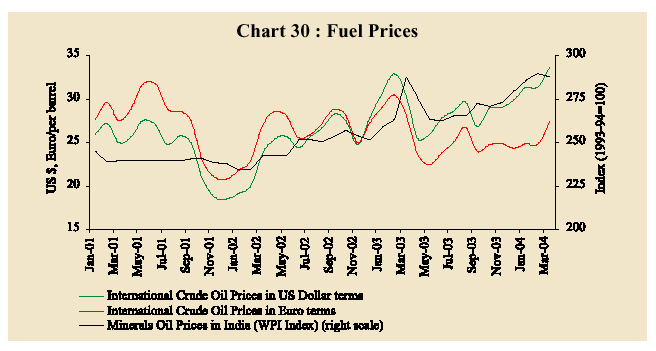
The strong rebound in agricultural production in 2003-04 generally dampened inflationary pressures in primary commodities (Chart 31). Vegetable prices, however, increased due to the impact of localised droughts in various parts of the country.
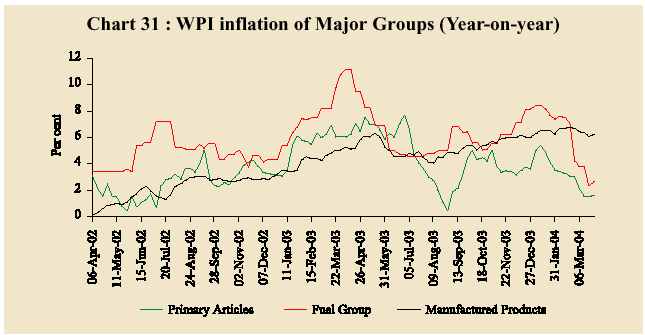
Consumer Price Inflation
Retail price inflation, measured by y-o-y variation in the consumer price index for industrial workers (CPI-IW), decelerated to 3.5 per cent in 2003-04 from 4.1 per cent a year ago. On an annual average basis also, CPI inflation at 3.9 per cent in 2003-04 was lower than 4.0 per cent in the previous year (Chart 32).
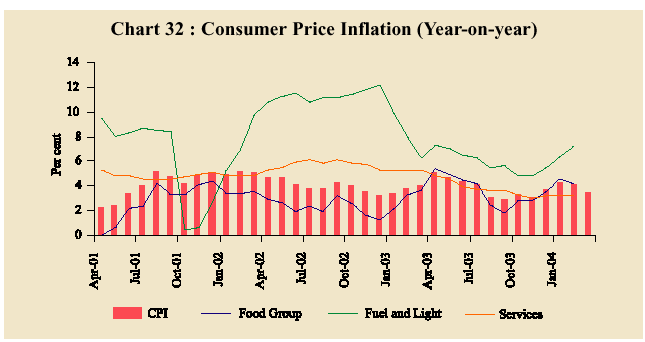
In contrast to WPI inflation, retail price inflation remained benign during 2003-04, reflecting the almost negligible weightage of iron and steel and lower weightage of fuel items - the two key movers of WPI inflation - in the CPI basket (Chart 33).
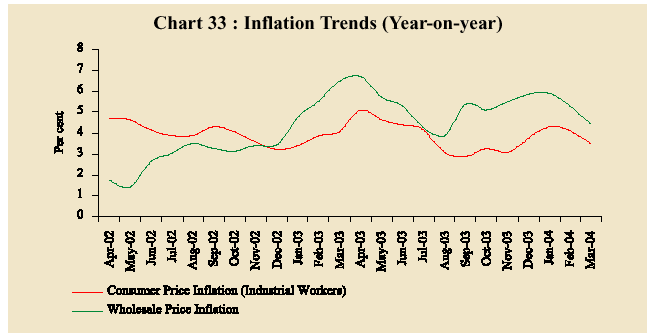
Asset Prices and Inflation
Asset prices contain information on how markets assess the benefits and risks of future macroeconomic developments. These expectations impact the current level of interest rates. Thus, asset prices provide a mechanism for a forward-looking monetary policy to be transmitted through financial markets to the real sector. Housing prices, exchange rates, stock prices and even prices of bullion have been identified as forming part of this transmission mechanism by generating wealth and competitiveness effects. Asset prices also affect balance sheets of banks as well as corporates and reinforce the credit channel of monetary policy transmission. During 2003-04, movements in equity and gold prices in India indicated a firming up of inflation expectations, partly offset by exchange rate appreciation and relatively stable housing prices (Chart 34).
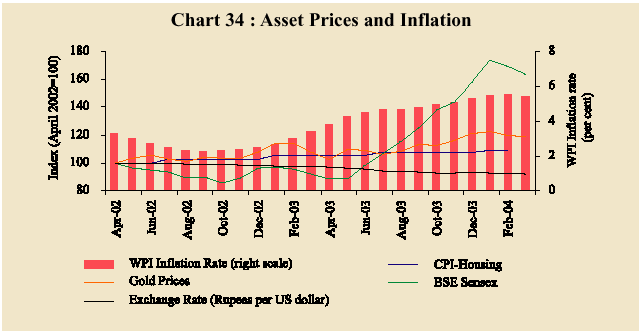
Outlook
Inflation remains low and stable worldwide. Deflation risks have receded with the strengthening of global recovery and a number of commodity prices have risen in recent months. Indeed, the outlook is now fraught with the upward risk emanating from commodity markets, although there are also prospects of commodity prices levelling off in the medium term. Considerable uncertainty surrounds the prospects of international crude oil prices. The depreciation of the US dollar could be indicative of incipient inflation, however benign it may be in the current phase of the business cycle. Prices of key agricultural commodities will depend upon weather conditions.
In India, as domestic economic activity strengthens, inflation is likely to respond, with specific demand-supply conditions in key movers – iron and steel, cotton and fuel – dominating intra-year movements. A potential inflexion in inflation ahead would be triggered by the timing of adjustments in the prices of administered items, as also the possibility of a further spurt in global commodity prices.
























